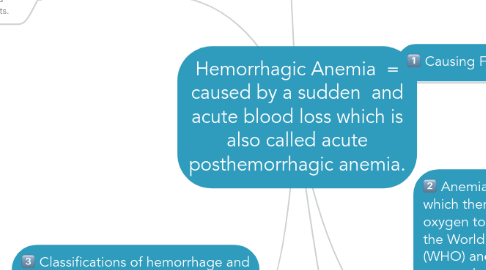
1. Classifications of hemorrhage and pathophysiological effects
1.1. Class I = blood loss <750ml, blood loss <15%, heart rate <100 beats/min, blood pressure normal, respiratory rate 14-20 breaths/min, urine output >30ml/hour, CNS symptoms normal.
1.2. Class II = blood loss 750-1500ml, blood loss 15-30%, heart rate >100 beats/min, blood pressure decreased, respiratory rate 20-30 breaths/min, urine output 20-30ml/hr, CNS anxious.
1.3. Class III = blood loss 1500-2000ml, blood loss 30-40%, heart rate >120 beats/min, blood pressure decreased, respiratory rate 30-40, urine output 5-15 ml/hr, CNS confused.
1.4. Class IV = blood loss >2000ml, blood loss >40%, heart rate >140 beats/min, blood pressure decreased, respiratory rate >35 breaths/min, urine output negligible, CNS lethargic.
1.4.1. Effects lead to hemorrhagic shock = if too much blood volume is lost, a condition known as hypovolemic shock can occur. Hypovolemic shock is a medical emergency in which severe blood and fluid loss prevents the heart to pump sufficient blood to the body. As a result, tissues cannot get enough oxygen, leading to tissue and organ damage and eventually death
1.4.2. Conclusion - Primary goal is to control the bleeding and restore circulating blood volume to increase intravascular volume, maintain oxygen delivery to increase tissue perfusion and prevent cellular hypoxia, organ damage, and death.
2. Treatment
2.1. Surgery= to correct the bleeding and/or fix the injury to control hemorrhage.
2.2. General = Control bleeding, Blood transfusions (to assist in replacing the massive blood loss), oxygen (assist with maintaining oxygen in blood) , fluids IV or by mouth as tolerated (to help increase blood pressure), bed rest due to fatigue from blood loss, diet high in protein and iron.
2.3. Drugs = Iron replacement
3. Diagnosing
3.1. Blood tests are used to check the number of red blood cells, white blood cells, and platelets. Platelets are the sticky part of your blood that helps form clots to stop bleeding. The tests may also be used to find how well your blood can form clots.
4. Causing Factors
4.1. Trauma or surgery that causes massive blood loss
4.2. Severe bleeding in the stomach caused from an ulcer or from women's monthly periods that are heavy
4.3. Bleeding disorder such as hemophilia, being on blood thinner or antiplatelet medications or family history of blood disease or anemia.
4.3.1. Inspire someone about your topic?
4.3.2. Specific grade?
4.3.3. Do your best work?
5. Anemia = anemia is a condition in which there is reduced delivery of oxygen to the tissues. According to the World Health Organization (WHO) anemia is considered when women has a hemoglobin less than 7.5 mmol/L and men less than 8.1 mmol/L.
5.1. Compile some ideas
5.2. Supporting sources
5.2.1. Find examples
5.2.2. Find relevant quotes
5.2.3. References
5.2.3.1. Books
5.2.3.2. News sources
5.2.3.3. Blogs
5.2.3.4. Supporting Data
5.2.3.4.1. Expert reports
5.2.3.4.2. Third party research
5.2.3.4.3. Survey data
5.2.3.4.4. Size of topic

